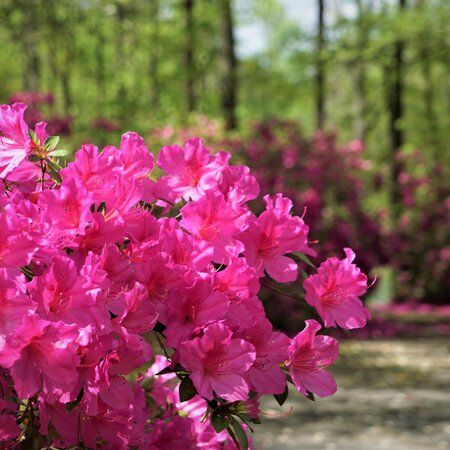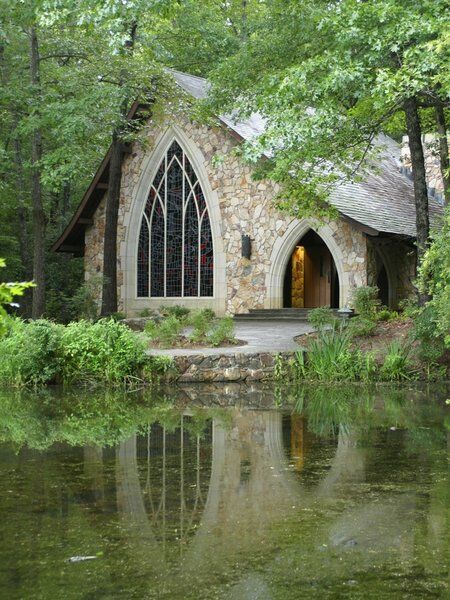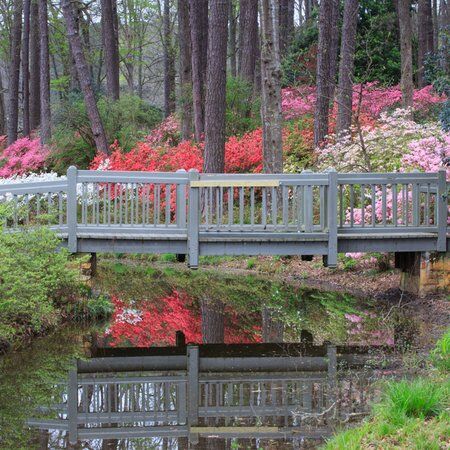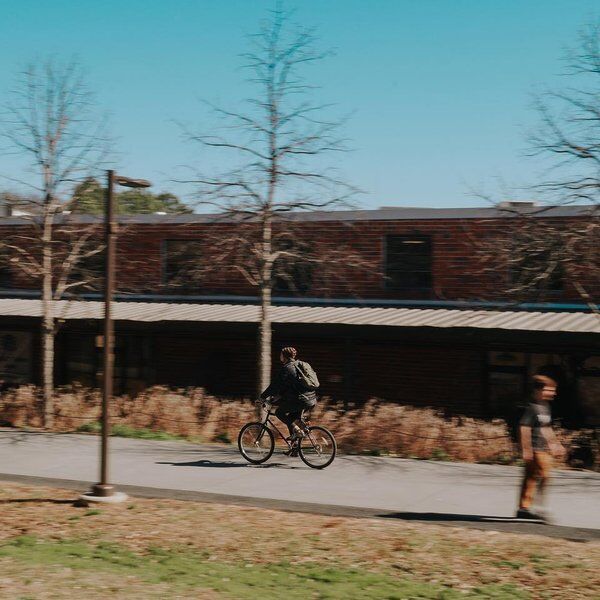
What are the Callaway Gardens?
Tucked away in the foothills of Pine Mountain, a short drive from Atlanta, Georgia, Callaway Gardens is a sprawling 2,500-acre paradise. The retreat is brimming with gardens, lakes, hiking trails, accommodation, and a variety of activities for visitors to enjoy.
Who were the Callaways?
The Gardens’ founders, Cason J. Callaway Sr. and his wife, Virginia Hand Callaway, were both passionate champions of conservation and preserving the natural world for future generations. Especially the slice of heaven they stumbled upon, which would later become the Callaway Gardens, in Harris County, Georgia.
Virginia in particular was always in awe of horticulture. In 1961 Cason passed away and she was left to continue their vision with the help of her son. An ode to her love-affair with nature can still be witnessed today in the year-round beauty of the Gardens.

The Origins of the Callaways Garden
Although the Callaway Gardens were established by Cason and Virginia in 1952, dreams of a garden that could (and would) become one of the most beloved destinations in Atlanta, originated many years before.
In the late 1920s the Callaways began venturing out to Blue Springs for picnics with their friends. A couple of years later in 1930, Cason discovered a Plumleaf Azalea – an incredibly rare flower – growing in the nearby woodland. A fascination with Blue Springs was well underway and that same year the Callaways slowly began purchasing large pockets of land in the area – they would go on to own around 40,000 acres at Blue Springs.

The Lodge at Blue Springs, was used as their family vacation home until Cason moved his family out to Blue Springs permanently, in 1935. Thoughts of a garden that could preserve the land and showcase its natural treasures for generations to come, began to take shape. Today the Callaways’ vision continues to provide wonder, comfort, and inspiration for all who visit.
Creating the Callaway Gardens
Despite the acquisition of land and the family’s relocation, it wasn’t until 1949, after a flood at Blue Springs Farm, that Cason and Virginia ploughed all their efforts into creating the Callaway Gardens.
Streams were dammed to create 13 lakes, crops were planted to restore nutrients to the soil, and silt-clogged wetlands were drained. With the help of notable landscape architect, Gilmore David Clarke, Virginia set about planting more than 20,000 trees, bushes, and flowers on the newly renovated land.
In 1950 the Callaways handed the deeds for the Gardens over to the Ida Cason Callaway Foundation. After a few more essential maintenance efforts, the Ida Cason Gardens, named for Cason’s mother, opened to the public on May 21st 1952 – it wasn’t until 1961 when they became the Callaway Gardens.
What is there to see at the Callaway Gardens?
Over the years, Callaway Gardens has become a leading destination for nature lovers and outdoor enthusiasts. The Gardens feature a wide range of natural habitats, including lakes, meadows, and forests, as well as a diverse array of wildlife, from butterflies and birds to deer and other animals.
The Gardens are also known for their, uh… gardens! Each of which have their own unique themes and are equally breathtaking. The Overlook Azalea Garden is a particular favourite, boasting stunning views of the surrounding landscape and a burst of colour each spring.
Virginia Hand Discovery Center
The 35,000 square foot Discovery Center, features an auditorium, art exhibits, interactive kiosks detailing the Gardens’ past and present, a gift shop, and an education wing. Within the education wing is the Crawleseum, and outside the Center is the MEGA BUGS Exhibit, TreeTop Adventure Zip Lines, and Vaughn-Jordan Backyard Wildlife Habitat Garden.
Birds of Prey Show
Another popular attraction at Callaway Gardens is the Birds of Prey show, where visitors can see a variety of different raptors in flight. The show is held twice daily (12:30 and 15:30) at the Discovery Amphitheater and is a thrilling experience for animal lovers.
The Cecil B. Day Butterfly Center
As a testament to the Callaway's legacy and passion for conservation, the Gardens have also become a hub for environmental education and research. One of the research facilities (and most popular attractions onsite!) is the Cecil B. Day Butterfly Center, a giant glass enclosure home to more than 1,000 butterflies.
As one of North America’s largest tropical butterfly conservatories, the Butterfly Center at Callaway Gardens is a truly fascinating exhibit. Visitors can observe the types of tropical plants that provide nourishment for the butterflies and share their space with hundreds of vibrant fluttering species, from across the globe.

The Butterfly Center is not only a place to observe the butterflies – its a place of education! Visitors will come away having learnt: how to identify native butterflies and their host plants by performing scavenger hunt expeditions; the types of plants they can introduce to their own gardens to attract and support butterflies; how to capture and tag monarchs using an Entomologist; and key facts about the unsuspecting critters you capture.
Callaway Brothers Azalea Bowl
Azaleas have been blooming each year at Callaway Gardens for more than 65 years. The Callaway Brothers Azalea Bowl is a 40-acre garden dotted with more than 4,000 azaleas (over 700 different species) that each spring burst into a colourful array of pastel pinks, blues, and whites. The original Plumleaf Azalea, which captivated Cason Callaway in 1930, grows naturally within 100 miles of Callaway Gardens, blooming in the summertime. For his efforts in the conservation of the rare azalea, Cason received the Garden Club of America Fraces K. Hutchinson Medal.
The Azalea Bowl is named for Cason Callaway’s father and uncle, and has wide, winding pathways that zig-zag the hillside; unravelling into a peaceful voyage through a space filled not only with azaleas, but trees and shrubs that bloom throughout the year. At a nearby gazebo overlooking Falls Creek Lake, visitors can delight at the picture-perfect vista and breath in the fresh, floral air.
Ida Cason Callaway Memorial Chapel
Carefully planned by Cason Callaway, in honour of his mother, the Ida Cason Memorial Chapel is situated in the serenity of the trees encompassing Falls Creek Lake. By gently marrying 16th century Gothic architecture with native materials, including fieldstone quartz, the chapel is not only an homage to Cason’s mother but the land itself. This is especially true when looking at the Georgian pine trees depicted in the stained glass windows.

Things to do at the Callaway Gardens
Activities
For those who prefer more active pursuits, Callaway Gardens offers a range of activities to suit every taste. Visitors can either rent out bicycles and coast along the 10-mile track through the Gardens, or hike through the shade of the trees – either is a wonderful way to view everything the natural paradise has to offer! Kayak and paddleboard rentals are on hand to help visitors to navigate the lakes, so no area of the Gardens is left unexplored.
There are also golf courses, tennis courts, a spa, and a variety of restaurants, from casual cafes to fine dining. The newest restaurant is Casons' Tap Room, which was opened on 5th February, 2018 (Cason Callaway’s birthday) and offers craft beers. Inclduing their own brew, Casons.
Stay at Callaway Gardens
In addition to its natural beauty and outdoor activities, Callaway Gardens also allows visitors to become guests at the range of lodging options on offer. These include a luxurious resort hotel and charming cottages nestled in the woods.
The Lodge opened in November 2006 and formulated part of Cason and Virginia’s desire for people to be able to stay and experience the beauty of the Gardens, as they did in their own Blue Springs Lodge.
Celebrating Callaway Gardens
As environmental stewards, with an unwavering dedication to using sustainable practices the Callaways have produced a garden that has received recognition and numerous awards for their conservation efforts. They have also been branded a designated Wildlife Habitat by the National Wildlife Federation.

Who owns Callaway Gardens?
For many years the gardens were run by the Callaways. But following Virginia’s death in 1995 George P. Fischer became the third President & CEO of the Gardens. After 7 years Fischer resigned and Cason and Virginia’s grandson, Edward C. Callaway, took up the role until 2014. This signified the end of the Callaways’ management of the Gardens.
In 2022 Herschend Family Entertainment – who had been managing the site since 2020 – bought up the Gardens’ revenue-producing assets from the Ida Cason Callaway Foundation. The company also promised to invest $20 million dollars to renovate and improve the Gardens over the next 5 years, assuring the continuation of the Callaways’ vision.
We’re honoured to carry on the Callaway legacy by bringing our more than 70 years of experience in destination marketing to further develop Callaway as Georgia’s premier resort destination. We are wholeheartedly committed to preserving and strengthening all that makes Callaway so beloved and special — and look forward to celebrating the area’s natural beauty with a focused effort on world-class events and activities that complement the surrounding landscape.
Our thoughts…
The Callaway Gardens is a tale of one couple's vision and commitment to preserving and sharing the natural beauty of Georgia. They serve as a reminder of the importance of preserving the environment so that it might be enjoyed by future generations. Whether that means exploring the outdoors, learning about butterflies and other wildlife, or simply relaxing on the beach.
















